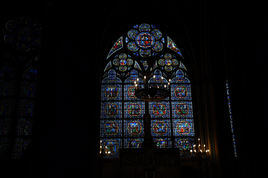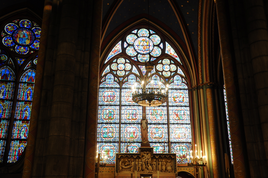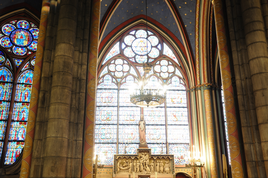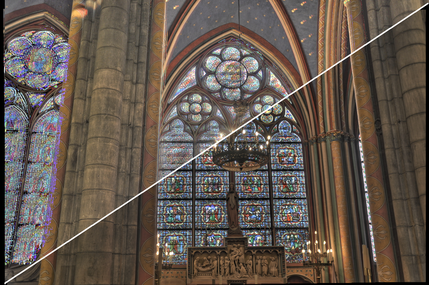
Welcome to the homepage of the lecture
Advanced Image Analysis
Winter Term 2015/2016
Home
About Us
People
Teaching
Research
Publications
Awards
Links
Contact
Internal
Advanced Image Analysis
Winter Term 2015/2016
Lecturer:
David Hafner
Examiner:
Prof. Joachim Weickert
Lectures (2h) with theoretical and programming exercises (2h)
6 ETCS points
Lectures: Monday, 14-16 c.t.
Lectures: Building E1.3, Lecture Hall 001
First lecture: Monday, October 26, 2015
Tutorials: Friday, 14-16 c.t.
Tutorials: Building E1.3, Seminar Room 0.16 (theory)
Tutorials: Building E1.3, CIP-Pool 104 (programming)
First tutorial: Friday, November 6, 2015 (theory)
News – Synopsis – Prerequisites – Registration – Contents – Tutorials and Assignments – Exams – References
| 23/03/2016: |
The results for the second written exam are available
here. Exam inspection offered in Room 4.10, Building E1.7, Wednesday, March 30, 2016, 15-16 s.t. |
| 16/02/2016: |
The results for the first written exam are available
here. Exam inspection offered in Room 4.10, Building E1.7, Tuesday, February 23, 2016, 15-16 s.t. |
| 05/02/2016: | Optional tutorial for a discussion of the self test problem offered on Friday, February 12, 2016 in Seminar Room 0.16, Building E1.3. |
| 02/02/2016: | Self test problem is online. |
| 03/12/2015: | Updated Silde 8 of Lecture 6. |
| 05/11/2015: | Updated first theoretical assignment sheet with general information. |
| 02/11/2015: | The registration to the system of the MIA group is now closed. |
| 26/10/2015: | The registration to the system of the MIA group is now open. |
| 13/10/2015: | First lecture on Monday, October 26, 2015 in Building E1.3, Lecture Hall 001. |
| 30/07/2015: | Course homepage online. Important news will be posted here. |
In this lecture, we will discuss advanced topics in the fields of image processing
and computer vision. Most of the presented methods fuse the information from several
images in order to produce an enhanced composite image. Examples for such techniques
are super-resolution, high dynamic range (HDR) imaging, tone mapping and
gradient domain techniques.
Example: Freehand High Dynamic Range Imaging



|

|
| Exposure series | Tone mapped HDR reconstruction without and with alignment |
Requires undergraduate knowledge in mathematics (e.g. ''Mathematik für Informatiker I-III''), and elementary C knowledge. Basic knowledge in image processing and computer vision is recommendable. The lectures and tutorials will be given in English.
In order to participate in the lecture/exam you have to register twice:
- Firstly, you have to register online to the system of the MIA group. This gives us an estimate of the number of students attending the course and allows us to check the attendence in the tutorials. This registration is closed.
- Secondly, depending on your field of study, you have to register online for the lecture/exam in the general system of Saarland University: the HISPOS system.
Participants of the course can download the lecture materials here shortly before the lecture
(access is password-protected). However, be aware that these slides are only provided
to support the classroom teaching, not to replace it. Additional organisational information,
further examples and explanations, which may be helpful or necessary to understand the content
of the course (and thus relevant for the exam), will be provided in the lectures. It is
solely your responsibility - not ours - to make sure that you receive this infomation. The
following table shows a preliminary list of topics that will be covered during the semester
(content may change slightly).
| Date | Lecture | Topic |
|---|---|---|
| 26/10 | Lecture 1 | Introduction and Overview |
| 02/11 | Lecture 2 | Finding Correspondences |
| 09/11 | Lecture 3 | Super-Resolution |
| 16/11 | Lecture 4 | High Dynamic Range Imaging |
| 23/11 | Lecture 5 | Tone Mapping I: Global and Local Operators |
| 30/11 | Lecture 6 | Tone Mapping II: Frequency and Gradient Domain Operators |
| 07/12 | Lecture 7 | Exposure Fusion |
| 14/12 | Lecture 8 | Alignment of Exposure Series I: Global Motion |
| 04/01 | Lecture 9 | Alignment of Exposure Series II: Local Motion |
| 11/01 | Lecture 10 | Deghosting and Joint Super-Resolution and HDR |
| 18/01 | Lecture 11 | Focus Stacking |
| 25/01 | Lecture 12 | Gradient Domain Techniques I: Basics |
| 01/02 | Lecture 13 | Gradient Domain Techniques II: Applications |
| 01/02 | Lecture 14 | Summary and Outlook |
Each week we have either a theory or a programming tutorial. They take place in:
Building E1.3, Seminar Room 0.16 (theory)
Building E1.3, CIP-Pool 104 (programming)
Programming excercises and theoretical assignments are offered as part of the tutorials.
The regular attendance of these tutorials is required for the admission to the exam.
You will not be allowed to take part in the exam if you miss more than two tutorials.
The assignments and the source code needed for the programming assignments will be provided here during the semester.
| Date | Assignment | Material |
|---|---|---|
| 06/11 | Assignment 1 (theory) | |
| 13/11 | Assignment 2 (programming) | Sources Solution |
| 20/11 | Assignment 3 (theory) | |
| 27/11 | Assignment 4 (programming) | Sources Solution |
| 04/12 | Assignment 5 (theory) | |
| 11/12 | Assignment 6 (programming) | Sources Solution |
| 18/12 | Assignment 7 (theory) | |
| 08/01 | Assignment 8 (programming) | Sources Solution |
| 15/01 | Assignment 9 (theory) | |
| 22/01 | Assignment 10 (programming) | Sources Solution |
| 29/01 | Assignment 11 (theory) | |
| 05/02 | Assignment 12 (programming) | Sources Solution |
| 12/02 | Self Test Problem (optional) |
In order to qualify for the exams, attendance of the tutorials is mandatory.
You will not be allowed to take part in the exams if you miss more than two tutorials.
In case of qualification, you are allowed to take part in both exams. The final grade
will be the best grade out of the two exams.
There will be two closed book written exams:
The first written exam will take place on
Monday, February 15, 2016, 10-12 s.t., Building E1.3, Lecture Hall 002.
The second written exam will take place on
Tuesday, March 22, 2016, 10-12 s.t., Building E1.3, Lecture Hall 002.
The results of the first written exam are available:
Check Your result here.
The distribution of the grades with the corresponding grading key can be found
here.
Each student who participated in the first written exam has the
opportunity to inspect her/his graded solutions in
Room 4.10, Building E1.7, Tuesday, February 23, 2016, 15-16 s.t.
The results of the second written exam are available:
Check Your result here.
The distribution of the grades with the corresponding grading key can be found
here.
Each student who participated in the second written exam has the
opportunity to inspect her/his graded solutions in
Room 4.10, Building E1.7, Wednesday, March 30, 2016, 15-16 s.t.
There is no specific book that covers the complete content of this class.
Many lectures will be based on articles from journals and conferences.
However, the recent book of R. Szeliski covers some of the topics and
additionally summarises most of the intensively studied areas of computer
vision research:
R. Szeliski: Computer Vision: Algorithms and Applications.
ISBN: 978-1-84882-934-3, Springer, Berlin, 2011.
Note: You can download a PDF version of the book here.
MIA Group
©2001-2023
The author is not
responsible for
the content of
external pages.
Imprint -
Data protection